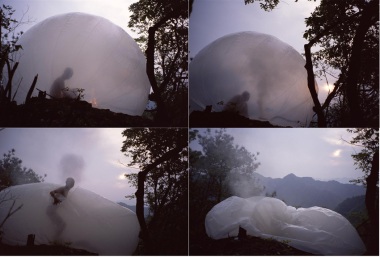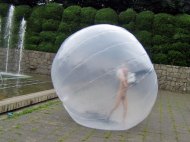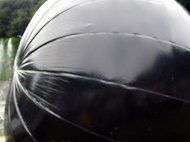MOUNTAIN ROCK SERIES
CURATED BY WU HUNG
June 2 - July 9, 2011
opening reception: June 2 (5-8pm)

Image:10 o'clock July 27, 2008 No. A, In Xiaogling Liangshanzhou Sichuan, China, Photograph
Chicago, Illinois : Mountain Rock Series by Zhu Ming curated by Wu Hung.
The exhibition Mountain Rock Series is a titillating combination of photos, videos and paintings by Beijing artist Zhu Ming. His signature style balloon performances are juxtaposed alongside his recent paintings which examine the dual roles of illusion and reality and their interchangeable nature. Foremost contemporary art scholar Wu Hung curated the exhibition. The show opens Thursday June 2nd from 5-8 pm. The artist and curator will be present.
Zhu Ming moved to Beijing as a teenager in 1992 "for art." He became an active member of the East Village artist community, which was the founding place in China for experimental art of all kinds. Zhu Ming created a few key performances using bubbles before being arrested and detained by the Chinese police for 3 months in 1994. However several years after his arrest, Zhu Ming transitioned from bubbles to balloons creating his signature style of performance in which he submerges himself in a sealed balloon that is gradually filled with water. Walsh Gallery's exhibition will show several photos and videos which document these extraordinary performances both in China and abroad. The performances took place in a series of environmentally challenging surroundings, namely in the sea and on mountains. Each performance required great presence of mind as well as challenged the artist's basic survival since there was only a limited amount of air in the balloons. Once Mr. Zhu even created a fire inside of the balloon for the effect of smoke.
Zhu Ming has always been intrigued by concepts of self-isolation, nihilism, and the time-space continuum. Before beginning his newest paintings called Mountain Rock Series, the artist created a series of performances in which he covered himself with toxic fluorescent powder and photographed himself in total darkness. These performances examined the interdependent nature of reality and illusion. It was these philosophical explorations that lead to his current paintings Mountain Rock Series.
These paintings juxtapose more traditional renderings of mountains made by conventional material with those same renderings glowing under fluorescent lighting controlled by a timer. The lighted presentation of the mountains is symbolic of 3 gateways: The first is a "material gateway" which can be seen in a realistically lighted presentation, the second is a "spiritual gateway" which is best seen in the absence of light, and the third is a "gateway of games and rules" which is seen through the interaction of environmental factors and people.
Zhu Ming's performances helped define the genre in performance art in China for future generations. His performances have been seen around the world including the Tate Modern (London), The Victoria and Albert Museum (London), ICP(New York), Museum of Modern Art (Denmark). In 2009 Mr. Zhu was invited to do one of his balloon performances on the beach for Miami Basel. Additionally Zhu Ming has participated in seminal exhibitions both in China and abroad including Fuck Off (Shanghai) and Between Past Present and Future : New Photography and Video From China (New York - Chicago - Berlin - Santa Barbara). Zhu Ming lives and works in Beijing.
Zhu Ming flings his frail naked self into the throws of modern life via an inflated, translucent womb and carefully engineered umbilical cord. His visceral performances courageously deconstruct respected icons of confidence by confronting isolation instead of covering it with pristine silk suits and carefully-pruned avenues. Tear off your clothes and feel the wind. Your age-associated neural modulation of hormones will thank you for redefining what it means to be respectable and adult.















